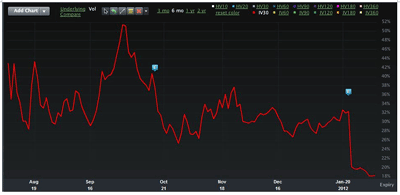By monitoring implied volatility levels and not trying to pick exact tops or bottoms, traders can use a similar strategy as market makers when deciding whether to buy or sell option premium.
Option traders, today we want to get a little more philosophical than we normally do. Last week, I spent much of the time pointing out to fellow traders that several stocks were hitting multi-year implied volatility lows—Google (GOOG) and Apple (AAPL) to name just two. Even names like the banks and Select Sector SPDR – Financial (XLF) are starting to get “cheap.”
This led us to the question, “When is the best time to buy option premium?”
From a market makers perspective, I would argue that this is a hard question to answer. Obviously, like all traders, market makers would love to be able to buy the absolute bottom of the barrel in volatility. However, it tends not to work that way. Take a look at a recent chart below from LiveVolPro:
If I didn’t tell you specifically that this is a graph of Apple (AAPL) option implied volatility (IV), you might think that it was a biotech that had an FDA announcement go against it.
You could easily think that it is a stock price, and a good market maker trades options like it is the stock price. He or she makes a market around the volatility, not to actually take a position in volatility.
See related: 3 Pricing Factors Option Traders Must Know
No market maker would choose to put on a big position into AAPL earnings (although they are often forced to). Basically, market makers try to begin to accumulate options when volatilities (vols) are really cheap and then build a position. This allows them to sell the options on the way up; it is how they manage demand.
But what about the retail trader? Should the retail trader try to pick bottoms and tops in options? One could make an argument that they should in some of the index products, but in truth, probably not.
The difference between the market maker and the retail trader is the money and margin. Typically, a market maker can always afford to buy more or sell more of something (when they consistently can’t, that is a sign they are going to blow out someday). Retail traders do not have that luxury. They typically get one or maybe two times to pick the bottom or top, and then they are often out of dough.
Thus, I would argue that retail traders should not try to pick bottoms and tops, but actually try to pick the “hump.” By this I mean traders should wait until volatility ticks up off a bottom or down off a top and then jump in.
It can be tempting to try and pick exact points, but unless you have the ability to go in to a trade three to five times and do more, one should not attempt to pick bottoms and tops on straight volatility.
Naked positions should be done on the round, not on the top or the bottom.
Does this also apply to spreads? I can only answer that with a phrase I despise: “kind of.”
I would always argue that spreads give the trader a better ability to initiate a good trade. We at OptionPit would much rather see a condor or butterfly sold because the trader perceived the spread as expensive versus something mechanical like days to expiration. The former shows domain knowledge; the latter shows that a trader can read a calendar.
By Mark Sebastian of OptionPit.com






















